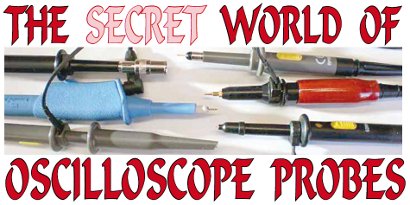Secret world of oscilloscope probles article written by Doug Ford and published by Silicon Chip magazine, describes how high frequency oscilloscope probes really work. Most textbooks treat scope probes as a combination of a resistive divider in combination with capacitors to provide an extended frequency response. But as will be revealed, the reality is that they are much more complex in principle. The hidden secret to designing a good 10x oscilloscope probe seems to be to use lossy transmission line cable! Usually the coax cable on probles has been made deliberately lossy, to reduce the effects of end-to-end transmission-line reflections!

63 Comments
Tomi Engdahl says:
eevBLAB 111 – The TMA Banning x1/x10 Switchable Probes?
https://www.youtube.com/watch?v=LeVZ5n3K2io
The Test and Measurement Alliance have announced an effective ban on x1/x10 switchable scope probes with all new oscilloscopes going forward from Q3 2023. Do you agree?
Signatories include practically every oscilloscope manufacturer! Keysight, Tektronix, Rohde & Schwarz, Lecroy, GW Instek, Siglent, Rigol, National Instruments, Hantek, Owon, Micsig and PicoScope.
https://tm-alliance.org/blog/2023-03-31/
Tomi Engdahl says:
Why sell one switchable probe, when you can sell 2 non-switchable probes.
Tomi Engdahl says:
https://www.eevblog.com/2023/04/01/eevblab-111-the-tma-banning-x1-x10-switchable-probes/
Tomi Engdahl says:
Press Release: The TMA Announces Retirement of x1/x10 Switchable Oscilloscope Probes
https://tm-alliance.org/blog/2023-03-31/
The TMA, an international alliance of Test and Measurement companies, today announces a significant industry-wide decision to retire x1/x10 switchable oscilloscope probes in all new Alliance Member oscilloscope products, effeective from the start of Q3 2023.
This decision is backed by industry-leading oscilloscope companies as part of the Test & Measurement Alliance, they include Keysight, Tektronix, Rohde & Schwarz, Lecroy, GW Instek, Siglent, Rigol, National Instruments, Hantek, Owon, and Micsig.
This proactive measure comes as a response to growing concerns about the limitations and potential risks associated with switchable probes.
Tomi Engdahl says:
They Banned My Probe!
https://www.youtube.com/watch?v=JD-vjV9jKgo
Tomi Engdahl says:
Getting the Most Out of 10x Passive Probes
https://teledynelecroy.com/doc/10x-passive-probes-appnote?utm_source=mwrf&utm_medium=banner-ad&utm_campaign=mwrf-ai-ads&utm_content=power-integrity
Introduction
Ironically, even as the 10x passive probe is the most commonly used probe with an oscilloscope, it is often misunderstood and used incorrectly. This Application Note explains how to get the most out of it by avoiding common artifacts.
Best Practices for 10x Probes
There are five important best measurement practices to consider when using the 10x probe. Follow these guidelines to get the best performance with a 10x probe and avoid common artifacts:
Always compensate the probe using the calibration (Cal) reference signal on the front panel of every oscilloscope.
Always try to use a tip geometry that minimizes the loop inductance. A small spring ground tip or a coaxial connection to the DUT will reduce the ringing artifacts and extend the probing bandwidth to the highest frequency.
Always try to use a coaxial connection to the DUT to reduce radio-frequency (RF) pickup from the local environment.
When probing a low-impedance source, consider adding a 200-Ω series resistance to damp out the ringing from the tip loop inductance and the input capacitance of the 10x probe.
Always remember that the input impedance of the 10x probe is a 9.5-pF capacitance; it is not 10 MΩ.
Tomi Engdahl says:
A 10x passive probe is the workhorse probe used for many routine measurements. Its application sweet spot is for signals with bandwidths 100 mV. Special care must be taken to perform reliable and accurate measurements outside of this range. Applying the best practices covered in the Application Note can increase the accuracy and reliability of measurements.
Tomi Engdahl says:
DIY Oscilloscope Leads
https://www.youtube.com/watch?v=U5yBlgHwVhs
Will these DIY scope leads compare to bought oscilloscope leads? We give them a test on CAN bus using the PicoScope 2204A. Making these oscilloscope leads was very easy, and the parts to make them very cheap! All we need is a BNC adapter and 4mm banana connector.
Tomi Engdahl says:
Robust High-Bandwidth Low-Cost Passive DIY Oscilloscope Probes
https://www.youtube.com/watch?v=JjoW2oXocwk
DIY oscilloscope probes that are easy to build, low cost, high bandwidth, robust, and flexible. Downside here is low impedance but in most cases it is worth the tradeoff.
https://nihtila.com/2019/03/16/tip-3-robust-high-bandwidth-passive-diy-probes/
Tomi Engdahl says:
EEVblog #1367 – 5 Types of Oscilloscope Passive Probes COMPARED
https://www.youtube.com/watch?v=rzo4Ntxqu1E
Tomi Engdahl says:
Probing Basics
https://www.youtube.com/watch?v=JAELtZ1MrwY
Making connection to your device under test is critical to accurate measurements. Learn the basics parts of the probing system and what they do.
https://beyondmeasure.rigoltech.com/acton/fs/blocks/showLandingPage/a/1579/p/p-0032/t/page/fm/0
Tomi Engdahl says:
How to make and Calibrate a Current Probe
https://www.youtube.com/watch?v=XSwVPvrJowI
How to make and Calibrate a Inductive Current Probe
Tomi Engdahl says:
Non Contact Scope Probe Costs Nearly Nothing
https://hackaday.com/2024/05/06/non-contact-scope-probe-costs-nearly-nothing/
[IMSAI Guy] wants you to build a non-contact scope probe. The cost? Assuming you have a bit of wire and a regular scope probe, it won’t cost you anything. Why do you want such a thing? You can see what he does with it in the video below.
The probe is really just a coil with little slip-over coils that grab it. You can stick it on and remove it just as easily, so you don’t have to sacrifice the probe for normal use. It won’t give you high-accuracy readings, but if you want to sniff around a circuit without directly connecting to it, it will do the trick. If you are too lazy to make a coil, you can even clip a ground lead to the probe tip, although that won’t work quite as well.
#1853 Free Oscilloscope Probe Attachment
https://www.youtube.com/watch?v=yCfeVyQD5sY